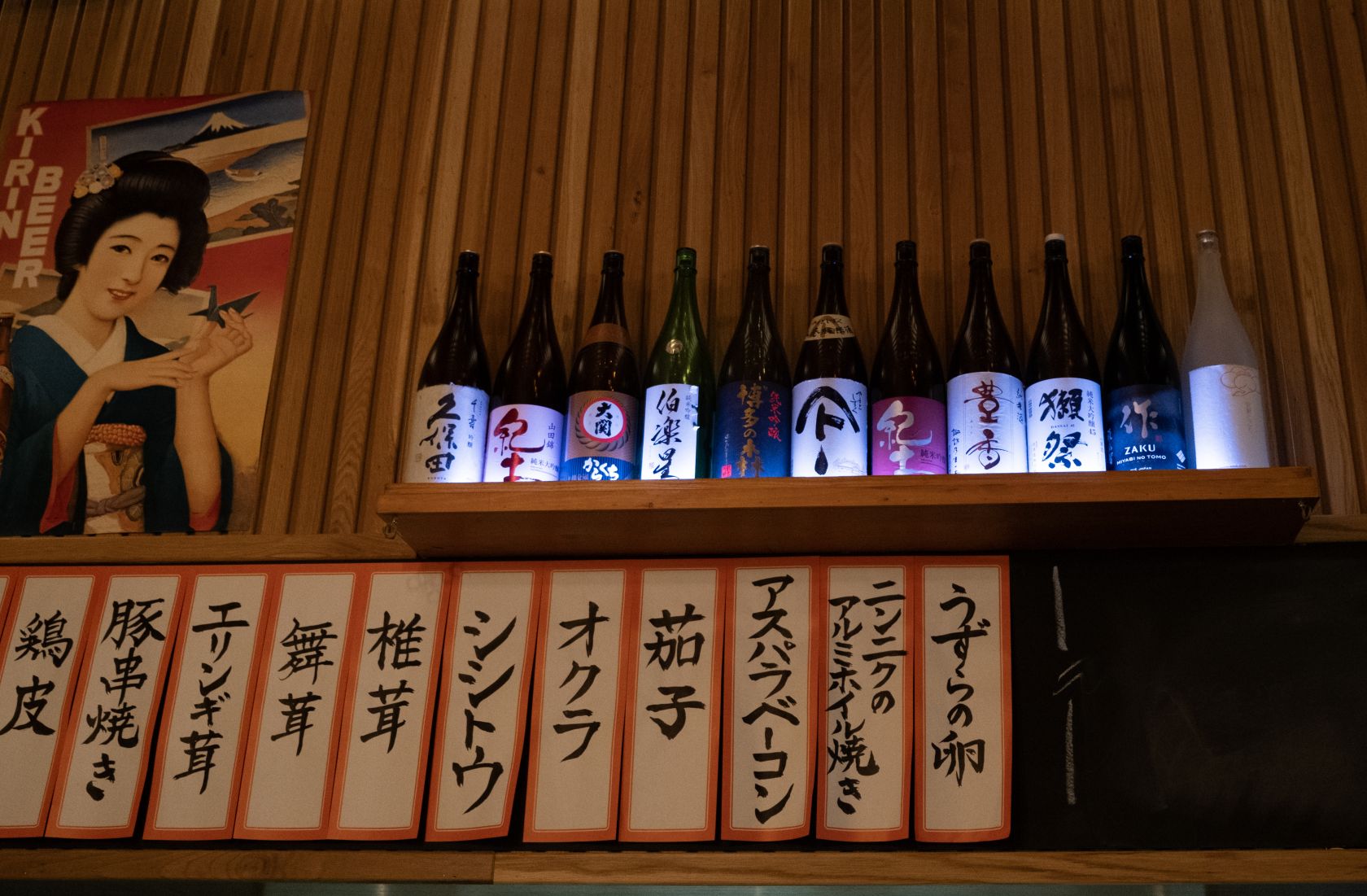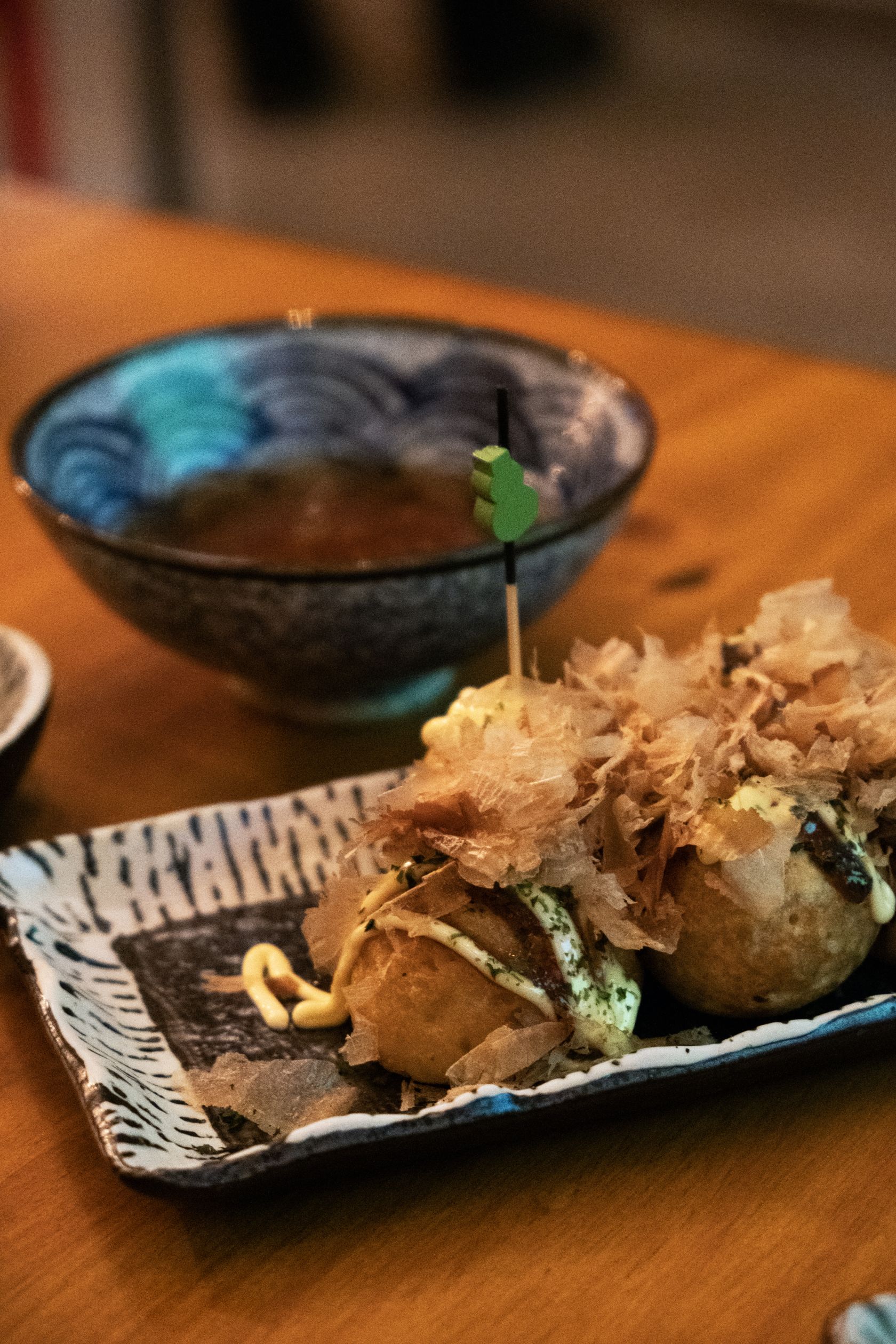Izakaya is the name for a traditional Japanese bar where the drinks are accompanied by affordable snacks and small dishes, usually for sharing. It’s a place to be social with your friends in a casual atmosphere, and now you can visit one right in the heart of Lisbon. Izakaya by Koji Lisboa is decorated just like a traditional Izakaya in Japan, complete with wooden ceilings, sumo wrestling game schedules, old Japanese beer ads and a big screen TV for showing sports. Aside from Porto playing Manchester United on the screen and the sound of the Portuguese speaking guests, you immediately feel transported to another world.

On one wall the panels are painted in the same colors as the curtains in a traditional Tokyo kabuki theater — just like the izakaya, this was the idea of Japanese executive Chef Koji Yokomizo. He partnered with owner Michel Weber in September 2021 to open an authentic Japanese restaurant in Lisbon, simply named by Koji Lisboa. After the success of which — and we will get to that later — they decided to add the izakaya to their roster.

“I was not convinced about those colors before they painted it, but I like them now,” laughs Weber as we sit down in the cosy bar for a chat and a taste of some of the dishes and drinks on the menu.
Apart from the wall colors the two partners have seen eye to eye on pretty much everything else. Both had lived many years in São Paulo but met by coincidence when Weber had lunch in Portugal’s oldest Japanese restaurant located in Porto.

“I saw him working there, and I said ‘You are gonna come work with me’,” Weber shares and continues: “I had knowledge of his skills from Brazil where he is very renowned, not least for his ability to extract the best cuts of fish, and where he has trained some of the best sushi chefs you can find. He is also the chef of the Japanese embassy here, and we cater the party they host to celebrate the birth of the emperor every year.”
Tradition and modernity
Some fusions also appear on the menu; like the cocktail caipirinha with sake and lychee and the fried mandioca with Japanese seasoning. On the drinks menu, you will find a map of Japan where you can see which region the different sakes are from. The history of the izakayas dates back more than 250 years but sake shops called ‘sakaya’ have been around since the 14th century.

“In Japan, you will find these on every street corner, but there were no real izakayas here in Portugal, maybe some ramen shops, but this is a bar with sake, Japanese beer and food to accompany it. Here it’s an unknown concept and people can be wary of coming in, they don’t know what to expect and they are very surprised when they enter,” says Weber.

And when they do, they will be able to accompany their drinks with a plethora of small dishes like pork belly Japanese style, spicy fermented cabbage, filled gyoza, meat skewers and Weber’s personal favorite for dessert: a pudding with plum liquor and sake on top. On our table arrives cold Japanese beer and warm tea for our host, followed by cold chicken soup, tempura vegetables and fried octopus balls. Japanese food is much more than sushi, although it can be pre-ordered on demand in the izakaya. All in all the food is very good here, and it’s a great experience if you want to try something different. The atmosphere is informal, authentic and welcoming and the place seamlessly combines tradition and modernity.

by Koji
Another gastronomic trip you can take to ‘the land of the rising sun’, without ever leaving Lisbon is the aforementioned restaurant by Koji Lisboa where the partnership between Weber and Yokomizo began. A more formal way of dining, and with a sophisticated atmosphere, we take to San Sebastián to try more of the cuisine of Chef Yokomizo. Here the master has another of his four restaurants (the other two are located in Brazil). The common denominator of the restaurants are the meticulous choice of the best and freshest ingredients combined with a tribute to Japanese culture and cuisine.

Opened in 2021, by Koji Lisboa is warm, welcoming and elegant — with tables for both a family gathering and a romantic dinner. There is an option to sit by the counter and watch the masterfully choreographed movements of the sushi chefs, handling their knives with utmost precision and beautifully arranging the colorful cuts of fish and vegetables on the plates before your eyes. Focus and professionalism is directed at the meticulously shaped nigiri and other sushi favorites.

We try the chutoro, kampachi and unagi nigiri, but only after the delicious braised tuna with ponzu sauce, crispy fried Shiso leaves with salmon tartar, shrimp cube tempura and the sashimi platter, containing some of the best cuts of raw fish this writer ever had.

The only drawback is that some of the dishes are in fact a bit too large, and the shrimp a bit heavy on the spicy sauce. For dessert try the Yuzu and black sesame ice cream and the dorayaki with chocolate — it’s unfortunately not homemade, but the taste is nonetheless very, very good and a perfect way to end the meal.

The restaurant is aware of buying sustainable fish, killed with the most humane methods as possible and the sake menu is a must if you want an authentic Japanese experience. It might seem very different from wine at first, but the high quality sakes here are fantastic. The sake sommelier will tell you all you need to know and suggest the best fit for your dishes. If you are looking to have a special night out and pay Japan a short visit, look no further than this outstanding restaurant.
















